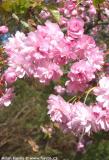Prunus subhirtella 'PENDULA RUBRA'

Prunus subhirtella 'PENDULA RUBRA'
Higan cherry
Higan cherry
| SIZE/TYPE | medium-sized tree |
|---|---|
| weeping/cascading | |
| USUAL HEIGHT | 3-6m |
| USUAL WIDTH | 3-6m |
| LEAVES | deciduous broadleaf |
| COLOUR OF LEAVES |
 green green |
| FLOWERS | showy |
| COLOUR OF FLOWERS |
 pink pink
|
| BLOOMING TIME | March - April |
| LOCATION | full sun |
| USDA zone (lowest) | 4 (down to -34°C) |
| WINTER PROTECTION | |
| FOR ZONE 5+6 |

|
| FOR ZONE 7 |

|
| BELONGS TO CATEGORIES | Deciduous broadleaf |
The prunus genus contains over 400 species which are useful and beautiful at the same time. They are cherries, plums, peaches or sloes, as well as flowering Japanese cherries, cherry laurels etc. Higan cherry is often classifies as a Japanese Zakura flowering cherry but in fact it is a different species – an ornamental plum tree. Never mind taxonomy, a flowering cherry tree is one of the most popular flowering trees of temperate climate around the world, and you can find at least one or two in every other Czech garden.
Pendula Rubra is a Higan cherry variety, a sister of Pendula Rosea. Compared to her sister it has darker pink flowers which open from richer pink buds and do not turn pale as they mature. They open from late March in such profusion that the tree looks like covered in pink snow. Blooming lasts for 2-3 weeks and only then appear the leaves. They are deciduous, smaller than those on common cherries, broadly elliptic, serrated at margins, emerge bronze, change to medium green, and turn orange and red in autumn. Its branches grow fast and are strictly weeping. In parks and arboretums with plenty of root space the tree can reach almost 8m in maturity but in gardens it is commonly about half the size.
Flowering cherries are not fussy about soil type and will grow in almost any but heavy and water-logged ground. They perform best in moist, fertile, acid soil which will enhance their autumn colours. Grow them only in full sun. Higan cherry is very resistant to hot sun as well as strong frost. It can be pruned (hard) after flowering. Hardy to about -34°C (USDA zone 4).
Last update: 06-03-2020
Pendula Rubra is a Higan cherry variety, a sister of Pendula Rosea. Compared to her sister it has darker pink flowers which open from richer pink buds and do not turn pale as they mature. They open from late March in such profusion that the tree looks like covered in pink snow. Blooming lasts for 2-3 weeks and only then appear the leaves. They are deciduous, smaller than those on common cherries, broadly elliptic, serrated at margins, emerge bronze, change to medium green, and turn orange and red in autumn. Its branches grow fast and are strictly weeping. In parks and arboretums with plenty of root space the tree can reach almost 8m in maturity but in gardens it is commonly about half the size.
Flowering cherries are not fussy about soil type and will grow in almost any but heavy and water-logged ground. They perform best in moist, fertile, acid soil which will enhance their autumn colours. Grow them only in full sun. Higan cherry is very resistant to hot sun as well as strong frost. It can be pruned (hard) after flowering. Hardy to about -34°C (USDA zone 4).
Last update: 06-03-2020
SIZES and PRICES
CURRENTLY SOLD OUT
GLOSSARY
|











